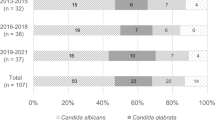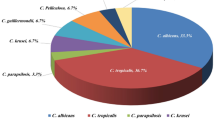Abstract
In a 1-year national surveillance program of Candida bloodstream infections in Japan, clinical factors predicting fluconazole resistance and survival of the patients were analyzed. Blood isolates and complete clinical histories were obtained from 326 patients. Fluconazole-resistant isolates were found in 15 (4.6%) of the cases. Univariate analysis of the demographic and clinical factors associated with fluconazole resistance revealed that age, hematologic malignancy, neutropenia, and immunosuppression were of statistical significance. A multiple logistic regression model showed that only hematologic malignancy as the underlying disease (odds ratio, 6.6; 95% confidence interval, 1.6–26.9; P=0.009) was independently associated with resistance. In 242 cases in which data regarding management and prognosis were available, the 30-day survival rate was 68.4%. In the univariate analysis of factors predicting survival, a significant association was found for Candida species, age of the patient, neutropenia, recent abdominal surgery, removal of the central venous catheter, and use of appropriate antifungal therapy. In the multivariate analysis, removal of the central venous catheter (odds ratio, 6.0; 95% confidence interval, 2.2–16.1; P<0.001) and the use of appropriate therapy (odds ratio, 2.1; 95% confidence interval, 1.1–4.1; P=0.03) were independent factors significantly associated with survival after the diagnosis of Candida bloodstream infection.
Similar content being viewed by others
References
Wey SB, Mori M, Pfaller MA, Woolson RF, Wenzel RP (1988) Hospital-acquired candidemia. The attributable mortality and excess length of stay. Arch Intern Med 148:2642–2645
Beck-Sague CM, Jarvis WR, the National Nosocomial Infections Surveillance System (1993) Secular trends in the epidemiology of nosocomial fungal infections in the United States. J Infect Dis 167:1247–1251
Fisher-Hoch SP, Hutwagner L (1995) Opportunistic candidiasis: an epidemic of the 1980s. Clin Infect Dis 21:897–904
Vincent JL, Bihari DJ, Suter PM, Bruining HA, White J, Nicolas-Chanoin MH, Wolff M, Spencer RC, Hemmer M (1995) The prevalence of nosocomial infection in intensive care units in Europe. Results of the European prevalence of infection in intensive care (EPIC) Study. EPIC International Advisory Committee. J Am Med Assoc 274:639–644
Voss A, Kluytmans JA, Koeleman JG, Spanjaard L, Vandenbroucke-Grauls CM, Verbrugh HA, Vos MC, Weersink AY, Hoogkamp-Korstanje JA, Meis JF (1996) Occurrence of yeast bloodstream infections between 1987 and 1995 in five Dutch university hospitals. Eur J Clin Microbiol Infect Dis 15:909–912
Edmond MB, Wallace SE, McClish DK, Pfaller MA, Jones RN, Wenzel RP (1999) Nosocomial blood stream infections in United States hospitals: a three-year analysis. Clin Infect Dis 29:239–244
Kao AS, Brandt ME, Pruitt WR, Conn LA, Perkins BA, Stevens DS, Baughman WS, Reingold AL, Rothrock GA, Pfaller MA, Pinner RW, Hajjeh RA (1999) The epidemiology of candidemia in two United States cities: results of a population-based active surveillance. Clin Infect Dis 29:1164–1170
Hope W, Morton A, Eisen DP (2002) Increase in prevalence of nosocomial non-Candida albicans candidaemia and the association of Candida krusei with fluconazole use. J Hosp Infect 50:56–65
Ásmundsdóttir LR, Erlendsdóttir H, Gottfredsson M (2002) Increasing incidence of candidemia: results from a 20-year nationwide study in Iceland. J Clin Microbiol 40:3489–3492
Poikonen E, Lyytikainen O, Anttila VJ, Ruutu P (2003) Candidemia in Finland, 1995–1999. Emerg Infect Dis 9:985–990
Jarvis WR (1995) Epidemiology of nosocomial fungal infections, with emphasis on Candida species. Clin Infect Dis 20:1526–1530
Pfaller MA, Messer SA, Houston MS, Rangel-Frausto MS, Wiblin T, Blumberg HM, Edwards JE, Jarvis W, Martin MA, Neu HC, Saiman L, Patterson JE, Dibb JC, Roldan CM, Rinaldi MG, Wenzel RP (1998) National Epidemiology of Mycoses Survey: a multicenter study of strain variation and antifungal susceptibility among isolates of Candida species. Diagn Microbiol Infect Dis 31:289–296
Pfaller MA, Jones RN, Doern GV, Sader HS, Hollis RJ, Messer SA, for the SENTRY Participant Group (1998) International surveillance of bloodstream infections due to Candida species: frequency of occurrence and antifungal susceptibilities of isolates collected in 1997 in the United States, Canada, and South America for the SENTRY Program. J Clin Microbiol 36:1886–1889
Chryssanthou E (2001) Trends in antifungal susceptibility among Swedish Candida species bloodstream isolates from 1994 to 1998: comparison of the E test and the Sensititre Yeast One colorimetric antifungal panel with the NCCLS M27-A reference method. J Clin Microbiol 39:4181–4183
St-Germain G, Laverdiere M, Pelletier R, Bourgault AM, Libman M, Lemieux C, Noel G (2001) Prevalence and antifungal susceptibility of 442 Candida isolates from blood and other normally sterile sites: results of a 2-year (1996–1998) multicenter surveillance study in Quebec, Canada. J Clin Microbiol 39:949–953
Diekema DJ, Messer SA, Brueggemann AB, Coffman SL, Doern GV, Herwaldt LA, Pfaller MA (2002) Epidemiology of candidemia: 3-year results from the Emerging Infections and the Epidemiology of Iowa Organisms Study. J Clin Microbiol 40:1298–1302
Pfaller MA, Diekema DJ (2002) Role of sentinel surveillance of candidemia: trends in species distribution and antifungal susceptibility. J Clin Microbiol 40:3551–3557
Cuenca-Estrella M, Rodero L, Garcia-Effron G, Rodriguez-Tudela JL (2002) Antifungal susceptibilities of Candida spp. isolated from blood in Spain and Argentina, 1996–1999. J Antimicrob Chemother 49:981–987
Pfaller MA, Diekema DJ, Jones RN, Messer SA, Hollis RJ, SENTRY Participants Group (2002) Trends in antifungal susceptibility of Candida spp. isolated from pediatric and adult patients with bloodstream infections: SENTRY Antimicrobial Surveillance Program, 1997 to 2000. J Clin Microbiol 40:852–856
Mora-Duarte J, Betts R, Rotstein C, Colombo AL, Thompson-Moya L, Smietana J, Lupinacci R, Sable C, Kartsonis N, Perfect J, Caspofungin Invasive Candidiasis Study Group (2002) Comparison of caspofungin and amphotericin B for invasive candidiasis. N Engl J Med 347:2020–2029
Johnson LB, Kauffman CA (2003) Voriconazole: a new triazole antifungal agent. Clin Infect Dis 36:630–637
Bross J, Talbot GH, Maislin G, Hurwitz S, Strom BL (1989) Risk factors for nosocomial candidemia: a case-control study. Am J Med 87:614–620
Wey SB, Mori M, Pfaller MA, Woolson RF, Wenzel RP (1989) Risk factors for hospital-acquired candidemia. Arch Intern Med 149:2349–2353
Richet HM, Andremont A, Tancrede C, Pico JL, Jarvis WR (1991) Risk factors for candidemia in patients with acute lymphocytic leukemia. Rev Infect Dis 13:211–215
Karabinis A, Hill C, Leclerg B, Tancrede C, Baume D, Andremont A (1988) Risk factors for candidemia in cancer patients: a case-control study. J Clin Microbiol 26:429–432
Kohmshian SV, Uwaydah A, Sobel JD, Crane LR (1989) Fungemia caused by Candida species and Torulopsis glabrata in the hospitalized patient: frequency, characteristics, and evaluation of factors influencing outcome. Rev Infect Dis 11:379–390
Schwartz RS, Mackintosh FR, Schrier SL, Greenberg PL (1984) Multivariate analysis of factors associated with invasive fungal disease during remission induction therapy for acute myelogenous leukemia. Cancer 53:411–419
Wiley JM, Smith N, Leventhal BG, Graham ML, Strauss LC, Hurwitz CA, Modlin J, Mellits D, Baumgardner R, Corden BJ, Civin CI (1990) Invasive fungal disease in pediatric acute leukemia with fever and neutropenia during induction chemotherapy: a multivariate analysis of risk factors. J Clin Oncol 8:280–286
Blumberg HM, Jarvis WR, Soucie JM, Edwards, Patterson JE, Pfaller MA, Rangel-Frausto MS, Rinaldi MG, Saiman L, Wiblin RT, Wenzel RP, the NEMIS Study Group (2001) Risk factors for candidal bloodstream infections in surgical intensive care unit patients: the NEMIS prospective multicenter study. Clin Infect Dis 33:177–186
Vazquez JA, Sanchez V, Dmochowski C, Dembry LM, Sobel JD, Zervos MJ (1993) Nosocomial acquisition of Candida albicans: an epidemiologic study. J Infect Dis 168:195–201
Fraser VJ, Jones M, Dunkel J, Storfer S, Medoff G, Dunagan WC (1992) Candidemia in a tertiary care hospital: epidemiology, risk factors, and predictors of mortality. Clin Infect Dis 15:414–421
Nguyen MH, Peacock JE Jr, Tanner DC, Morris AJ, Nguyen ML, Snydman DR, Wagener MM, Yu VL (1995) Therapeutic approaches in patients with candidemia. Evaluation in a multicenter, prospective, observational study. Arch Intern Med 155:2429–2435
Anaissie EJ, Rex JH, Uzun O, Vartivarian S (1998) Predictors of adverse outcome in cancer patients with candidemia. Am J Med 104:238–245
Viscoli C, Girmenia C, Marinus A, Collette L, Martino P, Vandercam B, Doyen C, Lebeau B, Spence D, Krcmery V, De Pauw B, Meunier F, the Invasive Fungal Infection Group of the EORTC (1999) Candidemia in cancer patients: a prospective, multicenter surveillance study by the Invasive Fungal Infection Group (IFIG) of the European Organization for Research and Treatment of Cancer (EORTC). Clin Infect Dis 28:1071–1079
Pagano L, Antinori A, Ammassari A, Mele L, Nosari A, Melillo L, Martino B, Sanguinetti M, Equitani F, Nobile F, Carotenuto M, Morra E, Morace G, Leone G (1999) Retrospective study of candidemia in patients with hematological malignancies. Clinical features, risk factors and outcome of 76 episodes. Eur J Haematol 63:77–85
Macphail GL, Taylor GD, Buchanan-Chell M, Ross C, Wilson S, Kureishi A (2002) Epidemiology, treatment and outcome of candidemia: a five-year review at three Canadian hospitals. Mycoses 45:141–145
National Committee for Clinical Laboratory Standards (2002) Reference method for broth dilution antifungal susceptibility testing of yeasts. Approved standard M27-A2. NCCLS, Wayne
Weems JJ Jr (1992) Candida parapsilosis: epidemiology, pathogenicity, clinical manifestations, and antimicrobial susceptibility. Clin Infect Dis 14:756–766
Branchini ML, Pfaller MA, Rhine-Chalberg J, Frempong T, Isenberg HD (1994) Genotypic variation and slime production among blood and catheter isolates of Candida parapsilosis. J Clin Microbiol 32:452–456
Abi-Said D, Anaissie E, Uzun O, Raad I, Pinzcowski H, Vartivarian S (1997) The epidemiology of hematogenous candidiasis caused by different Candida species. Clin Infect Dis 24:1122–1128
Rex JH, Bennett JE, Sugar AM, Peter G, Pappas PG, van der Horst CM, Edwards JE, Washburn RG, Scheld WM, Karchmer AW, Dine AP, Levenstein MJ, Webb CD, the Candidemia Study Group and the National Institute of Allergy and Infectious Diseases Mycoses Study Group (1994) A randomized trial comparing fluconazole with amphotericin B for the treatment of candidemia in patients without neutropenia. N Engl J Med 331:1325–1330
Wingard JR, Merz WG, Rinaldi MG, Johnson TR, Karp JE, Saral R (1991) Increase in Candida krusei infection among patients with bone marrow transplantation and neutropenia treated prophylactically with fluconazole. N Engl J Med 325:1274–1277
Horn R, Wong B, Kiehn TE, Armstrong D (1985) Fungemia in a cancer hospital: changing frequency, earlier onset, and results of therapy. Rev Infect Dis 7:646–655
Girmenia C, Martino P, De Bernardis F, Gentile G, Boccanera M, Monaco M, Antonucci G, Cassone A (1996) Rising incidence of Candida parapsilosis fungemia in patients with hematologic malignancies: clinical aspects, predisposing factors, and differential pathogenicity of the causative strains. Clin Infect Dis 23:506–514
Wingard JR (1995) Importance of Candida species other than C. albicans as pathogens in oncology patients. Clin Infect Dis 20:115–125
Rex JH, Bennett JE, Sugar AM, Pappas PG, Serody J, Edwards JE, Washburn RG (1995) Intravascular catheter exchange and duration of candidemia. NIAID Mycoses Study Group and the Candidemia Study Group. Clin Infect Dis 21:994–996
Edwards JE Jr, Bodey GP, Bowden RA, Buchner T, de Pauw BE, Filler SG, Ghannoum MA, Glauser M, Herbrecht R, Kauffman CA, Kohno S, Martino P, Meunier F, Mori T, Pfaller MA, Rex JH, Rogers TR, Rubin RH, Solomkin J, Viscoli C, Walsh TJ, White M (1997) International conference for the development of a consensus on the management and prevention of severe candidal infections. Clin Infect Dis 25:43–59
Rex JH, Walsh TJ, Sobel JD, Filler SG, Pappas PG, Dismukes WE, Edwards JE (2000) Practice guidelines for the treatment of candidiasis. Infectious Diseases Society of America. Clin Infect Dis 30:662–678
Nucci M, Anaissie E (2002) Should vascular catheters be removed from all patients with candidemia? An evidence-based review. Clin Infect Dis 34:591–599
Acknowledgements
This study was supported in part by a grant-in-aid (no. 14572182) for scientific research from the Japan Society for the Promotion of Science, and by a research grant from Pfizer Pharmaceuticals. We express our appreciation to all the Japan Invasive Mycosis Surveillance (JIMS) study participants for providing isolates and clinical data, and to Izumi Sone and Koshu Kinoshita for their clerical assistance.
Author information
Authors and Affiliations
Consortia
Corresponding author
Rights and permissions
About this article
Cite this article
Takakura, S., Fujihara, N., Saito, T. et al. Clinical factors associated with fluconazole resistance and short-term survival in patients with Candida bloodstream infection. Eur J Clin Microbiol Infect Dis 23, 380–388 (2004). https://doi.org/10.1007/s10096-004-1128-2
Published:
Issue Date:
DOI: https://doi.org/10.1007/s10096-004-1128-2




